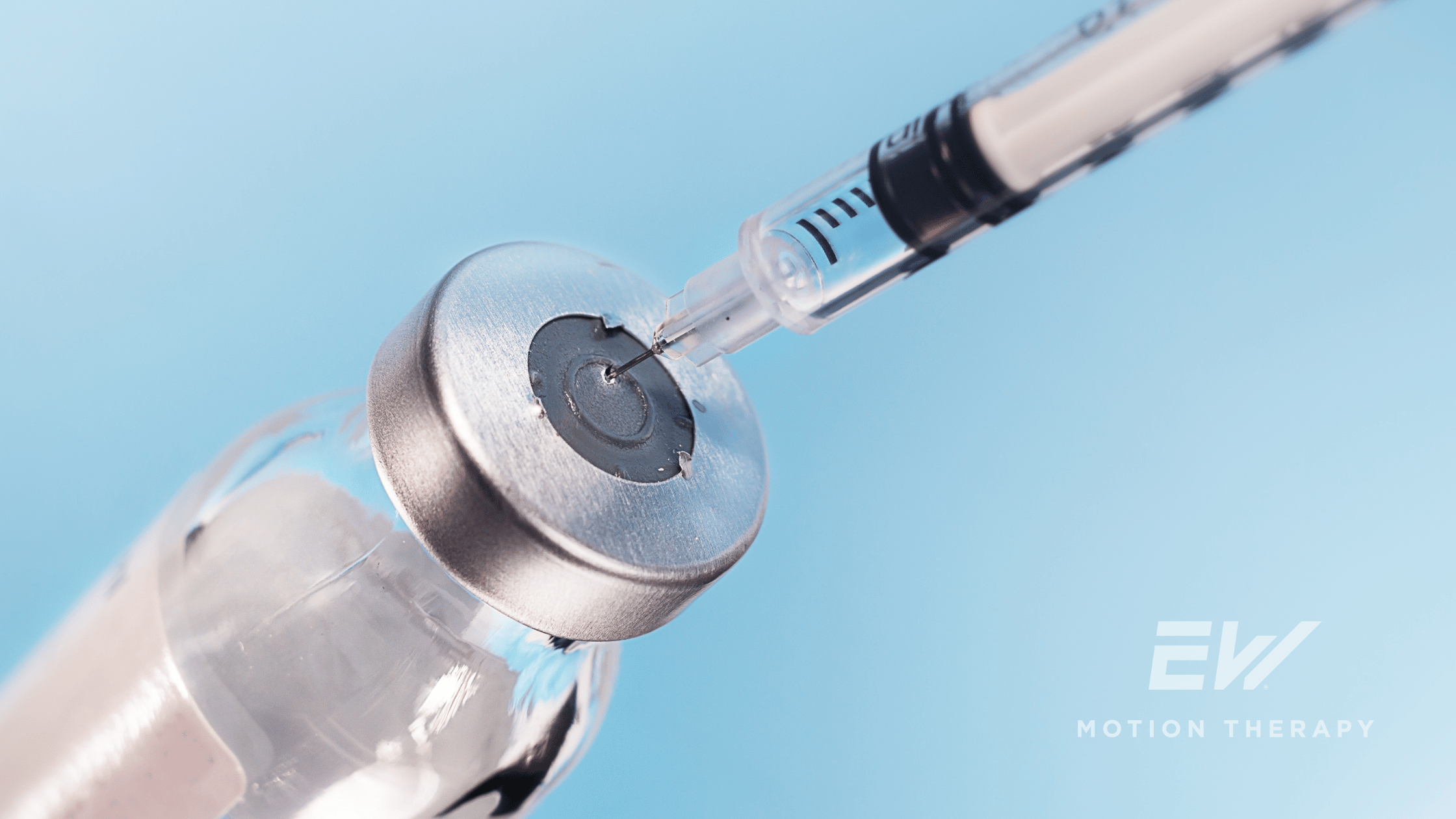The Benefits of Therapeutic Injections for Managing Pain

Licensed Physical Therapist, PT, DPT // Clinical Director of EW Motion Therapy Homewood
Chronic pain can significantly affect daily life, making routine activities difficult or even impossible. One way to combat chronic pain is using needles, but the fear of needles is common and widespread. However, when deemed necessary by healthcare providers, therapeutic injections can offer a minimally invasive solution to pain, providing relief while allowing you to continue daily tasks and participate in more extensive treatments like physical therapy. These injections can be integral to a comprehensive pain management plan, helping patients achieve lasting relief and improved function.
This article will explore the types of therapeutic injections available, how they alleviate pain when appropriate within a treatment plan, and how they complement physical therapy to provide the most comprehensive care.
Types of therapeutic injections for pain management
There are several types of therapeutic injections, each designed to target different kinds of pain. Whether dealing with joint issues, nerve pain, or muscle spasms, there’s likely an injection suited to your specific needs. Here are some of the most common therapeutic injections:
Corticosteroid injections
Corticosteroid injections are one of the most commonly prescribed types of injections for pain relief, particularly when inflammation is the underlying cause. These injections work by delivering a potent anti-inflammatory medication directly to the affected area, such as a joint or tendon. Conditions such as arthritis, tendinitis, and bursitis often respond well to corticosteroids. The primary benefit is their ability to quickly reduce inflammation, providing pain relief that can last for several weeks to months. This reduction in inflammation allows patients to engage in physical therapy and daily activities with reduced discomfort.
Hyaluronic acid injections
Hyaluronic acid injections are most commonly used in people suffering from osteoarthritis, particularly in the knee. This injection works by providing additional lubrication to the joint, helping to reduce pain caused by friction between the bones. The naturally occurring hyaluronic acid in our joints can break down over time, leading to increased pain and stiffness, especially in weight-bearing joints like the knees. These injections aim to replenish that lubrication, improve mobility, and reduce pain.
Trigger point injections
Trigger point injections relieve pain in areas where muscle knots or “trigger points” have developed. These tight bands of muscle can become a source of pain and limit mobility. During a trigger point injection, a healthcare provider injects a small amount of anesthetic or corticosteroid solution directly into the trigger point, which helps relax the muscle and alleviate pain. These injections often treat conditions like myofascial pain syndrome or muscle spasms. The relief from trigger point injections can last from a few weeks to several months, depending on the individual.
Epidural steroid injections
Epidural steroid injections are a type of injection used to treat nerve pain, particularly pain that radiates from the spine, such as sciatica. This procedure involves injecting a corticosteroid and anesthetic into the epidural space of the spine, where the nerve roots are located. This reduces inflammation around the nerve, providing pain relief that can last for several weeks. Epidural injections are often recommended for individuals with herniated discs, spinal stenosis, or other conditions that cause nerve compression and result in radiating pain down the arms or legs.
Nerve block injections
Nerve block injections block pain signals from a specific nerve or group of nerves. A local anesthetic, sometimes combined with an anti-inflammatory, is injected near the nerve that is causing pain. Nerve blocks can be used for both diagnostic and therapeutic purposes. For example, if the injection relieves pain, it helps confirm that the targeted nerve is responsible for the pain. These injections are commonly used for conditions like sciatica, complex regional pain syndrome (CRPS), shingles, or severe post-surgical pain.
How therapeutic injections help with pain management
Therapeutic injections offer targeted pain relief, addressing the underlying causes of pain while avoiding the systemic side effects associated with oral pain medications. Here's how these injections contribute to effective pain management:
- Targeted pain relief: Therapeutic injections precisely target the painful area, delivering medication exactly where needed. This direct approach ensures faster pain relief and allows for more localized treatment, minimizing the impact on other areas of the body.
- Reduction of inflammation: Many therapeutic injections, such as corticosteroids and epidurals, are designed to reduce inflammation, often the root cause of chronic pain. By lowering inflammation, these injections alleviate pain and reduce swelling and stiffness, improving mobility and function.
- Improved function and mobility: With reduced pain, individuals can move freely and engage in activities they may have been avoiding. This can be particularly beneficial for patients undergoing physical therapy, as pain relief allows them to perform exercises more effectively and work toward long-term improvement.
- Delaying or avoiding surgery: For many patients, therapeutic injections provide a viable option for managing pain and avoiding or delaying surgery. Joint replacement, spinal surgery, or other invasive procedures may be postponed by using injections to control symptoms effectively over time.
When are therapeutic injections appropriate?
Therapeutic injections are typically only considered when other treatments have not provided sufficient relief. Your doctor and physical therapist will ultimately decide whether a therapeutic injection is the best approach to reducing your pain. Injections may be appropriate in the following scenarios:
When conservative treatments aren’t enough
If physical therapy, medication, or lifestyle modifications have not sufficiently alleviated pain, injections may be the next step. These injections can offer immediate relief, making it easier for patients to continue other treatments.
To enable participation in other therapies
Sometimes, patients may be in too much pain to fully participate in physical therapy. Injections can reduce pain enough to allow for active participation in therapy sessions, which is crucial for long-term recovery and improved function.
Diagnostic uses
Certain injections, like nerve blocks, determine the exact source of pain. If an injection provides temporary relief, it helps physicians confirm the diagnosis and plan future treatments accordingly.
As a bridge to surgery
For some patients, therapeutic injections can help manage symptoms while waiting for surgery or can serve as a temporary measure if surgery is not yet recommended. For example, hyaluronic acid injections may allow a patient with knee arthritis to delay joint replacement surgery.
How therapeutic injections complement physical therapy
One of the most effective ways to use therapeutic injections is in combination with physical therapy. While injections provide short-term relief, physical therapy addresses the underlying biomechanical or functional issues that contribute to pain. When combined, they create a comprehensive approach to pain management and recovery. Here’s how therapeutic injections and physical therapy complement each other:
Reducing pain to enable movement
Injections can reduce pain enough for patients to engage in physical therapy fully. With less pain, individuals can perform strengthening and flexibility exercises, helping to restore function and prevent future injuries.
Addressing the root cause of pain
While injections can reduce symptoms, they don’t correct the underlying issues that cause pain, such as muscle imbalances or poor posture. Physical therapy focuses on correcting these issues, providing long-term relief, and preventing recurrence.
Enhancing recovery
Injections can help reduce pain levels for patients recovering from injuries, allowing them to progress through physical therapy more effectively. This combination of treatments helps patients regain strength and mobility more quickly than either approach alone.
Preventing re-injury
Physical therapy not only helps reduce pain but also teaches patients how to move properly and strengthen their bodies to avoid future injury. By combining therapeutic injections with physical therapy, patients benefit from immediate pain relief and long-term functional improvements. Always consult with your healthcare provider to determine the best combination of treatments for your individual needs and goals.
Therapeutic injections play a vital role in managing pain, offering targeted relief while allowing individuals to remain active in their recovery journey. Whether you're dealing with arthritis, nerve pain, or muscle tightness, injections can provide the relief needed to engage in physical therapy and improve long-term outcomes. By working together, injections and physical therapy offer a balanced, effective approach to treating chronic pain and restoring function. At EW Motion Therapy, we love using physical therapy interventions and dry needling to help our patients reduce pain, improve mobility, and return to their favorite activities. To learn more about what physical therapy might cost for you, click the button below to download our free pricing guide.


